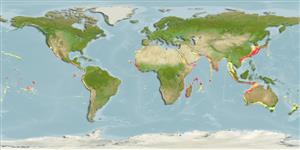Common names from other countries
Environment: milieu / climate zone / depth range / distribution range
Ecologia
marinhas associadas(os) a recifes; intervalo de profundidade 50 - 300 m (Ref. 28016). Subtropical; 35°N - 50°S, 32°E - 5°W
Southeast Atlantic: St. Helena and Ascension islands (Ref. 7097). Western Indian Ocean: southern Red Sea, off Oman and Sri Lanka. Eastern Pacific: Hawaiian and Revillagigedo islands (Ref. 9283). Reported from the Arafura Sea (Ref. 9819) and Persian Gulf (Ref. 68964).
Tamanho / Peso / Idade
Maturity: Lm ? range ? - ? cm
Max length : 58.0 cm TL macho/indeterminado; (Ref. 55763); common length : 35.0 cm TL macho/indeterminado; (Ref. 55763)
Espinhos dorsais (total) : 9; Raios dorsais moles (total) : 25 - 30; Espinhos anais: 3; Raios anais moles: 19 - 22.
Adults are benthopelagic in sandy bottoms at the foot of the edge of the outer reefs, continental coasts and around islands (Ref. 9283). Solitary or forming small schools (Ref. 30573). Mainly nocturnal (Ref. 4887). Marketed fresh and salted or dried (Ref. 9283).
Life cycle and mating behavior
Maturities | Reprodução | Spawnings | Egg(s) | Fecundities | Larvas
Smith-Vaniz, W.F., 1984. Carangidae. In W. Fischer and G. Bianchi (eds.) FAO species identification sheets for fishery purposes. Western Indian Ocean fishing area 51. Vol. 1. [pag. var.]. FAO, Rome. (Ref. 3287)
Categoria na Lista Vermelha da IUCN (Ref. 130435)
CITES (Ref. 128078)
Not Evaluated
Ameaça para o homem
Harmless
Utilização humana
Pescarias: pouco comercial; peixe desportivo: sim
Ferramentas
Relatórios especiais
Descarregue XML
Fontes da internet
Estimates based on models
Preferred temperature (Ref.
115969): 14.5 - 26.8, mean 20.2 (based on 410 cells).
Phylogenetic diversity index (Ref.
82804): PD
50 = 0.6250 [Uniqueness, from 0.5 = low to 2.0 = high].
Bayesian length-weight: a=0.01445 (0.00841 - 0.02484), b=2.94 (2.80 - 3.08), in cm Total Length, based on LWR estimates for this species & (Sub)family-body (Ref.
93245).
Nível Trófico (Ref.
69278): 3.8 ±0.58 se; based on food items.
Resiliência (Ref.
120179): Médio, tempo mínimo de duplicação da população 1,4 - 4,4 anos (Preliminary K or Fecundity.).
Fishing Vulnerability (Ref.
59153): Moderate vulnerability (43 of 100).
